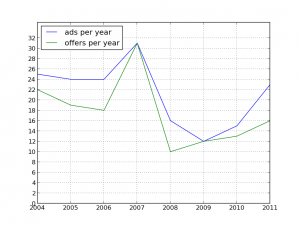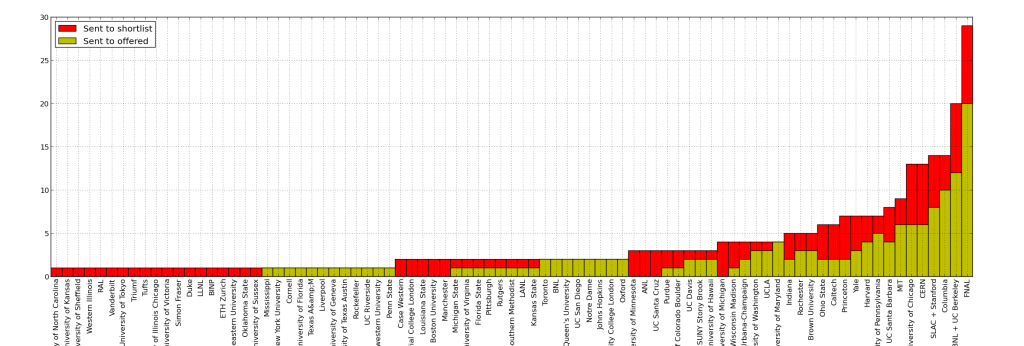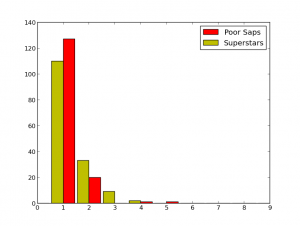TL;DR: The academic job market is looking bleaker than ever, and name brand recognition counts for a lot.
- Step 1: College Student, study hard.
- Step 2: Graduate Student, study hard, do research.
- Step 3: Postdoc, work hard, more reasearch, prove your chops.
- Step 4: Proffesor, kick back and relax, you’re set for life.
Ah, if only.
The postings have begun for this year’s set of junior and tenure track faculty positions. This affects me directly, since I’m somewhere around step 3.5. The truth of the matter, is that the job market for faculty positions is amazingly competitive, with few offerings and a sea of prospective applicants. A while ago, stuck at home while both Laureline and Jenn were sick as dogs, I had a little fun with the information up on the HEP Rumor Mill. The HEP Rumor Mill is exactly what it sounds like, completely unverified rumors about who has been short listed or made an offer high energy particle physics faculty jobs. They’ve got one page per year, going back to the 2004-2005 job cycle. All it requires to get the data is writing quick and dirty unstructured data parser. Ithought I’d share some of what I found. Note that all of what comes out of this is highly suspect. The short-lists and offers are un-verified, the names of candidates are sometimes misspelled, and I even caught one of two instances of someone’s affiliation being improperly reported.
Here you see the number of ads posted per year in blue, and the number of jobs for which an offer was made in green. You hear a lot of moaning about how bad the faculty job market has gotten recently. The numbers bear out this feeling, with about half as many jobs offered between 2008-2011 as had been offered between 2004-2007. Other sources indicate there were even more jobs available pre-2007. The lack of jobs is no surprise, really. The DOE budget for particle physics, adjusted for inflation, has stayed pegged between 9.6M and 11.1M dollars for the last decade.
There was a persistent myth at DØ that CDF was somehow doing a better job of getting their postdocs tenure-track positions. If I recall correctly, a DØ panel tasked with investigating this claim reported no clear sign of such an asymmetry. Yet, here it appears clear as day. The above plot was made by counting the number of times a candidate from an experiment made it onto a short-list (one count per year, so a candidate making it into multiple short-lists in one year shows up once, a candidate making it into a short-list two years in a row shows up twice). Those who were eventually made an offer show up in dark yellow, those who were made no offers show up in red. You’ll also note quite a bit of diversity in the field. The four major collider experiment detectors (CDF, DØ, ATLAS, and CMS) clearly dominate the field, but there’s a bunch of entries here from neutrino experiments, dark matter searches, some trailing candidates from LEP experiments (impressive since it shut down in 2000 and this data begins in 2007), etc… The strong showing of CDF and DØ with respect to ATLAS and CMS is somewhat unfair, since the LHC has only been in operation for three years. Looking only at the data from 2009 and on, the story is quite different.
What was that I mentioned about diversity? The news isn’t all bad… Well, for me at least. It’s pretty easy to make this kind of a graph using the home institution of the candidates.
Here I make the claim that your home institution can help you get your foot in the door (i.e. get you short-listed) but after that, getting hired is entirely up to you. Fermilab seems to do amazingly well, but these numbers are not normalized in any way, and they have a lot of postdocs. Combined, LBNL and Berkely do a very good job of promoting their postdocs as well, solidly dominating second place. I’m particularly impressed that Columbia does as well as SLAC and Stanford, combined, despite being a much smaller group. Still, as a postdoc at SLAC, seeing us tied for fourth place is fairly encouraging.
Looking at the rest of the names at the top of the list, the message is clear. Name brand recognition matters! There’s likely a lot going on behind this. The competition to nab one of those postdocs is also quite high, meaning there is some pre-vetting going on. But let’snot kid ourselves. Institutions like U. Chicago, Harvard, and Yale have been at this game for a long time, and the personal connections made by their scientists over the years can provide a crucial edge when reviewers go through a stack of applications.
I’ll end with one last figure. Below you can see the wall time of candidates, the number of years their name appears on the site. In yellow, the candidates who were eventually made an offer, in red those who never made it past the short-list.
So, lose not hope, you who have been denied in the past (unless you’ve been denied 5 times). 😉






The problem with sciecne as baseball analogy is the underlying assumption that a system based on fierce, cutthroat, ruthless competition produces the optimal result in an academic context.Moreover, the whole sciecne as baseball analogy is mostly wrong anyway. Its no longer sciecne as baseball (that was in the 1960s), but rather sciecne as sweat shop labor . The system isn’t designed to select the best, its designed to generate hoards of low paid, hard working postdocs to do the grunt work. Invariably, some of these will be satisfactory enough to take over as professors and produce the next generation of toilers.The other problem with the sciecne as baseball model is pretty obvious and critical: the expected value. People dedicate their early lives to baseball because of the possibility of a huge payoff. Well, making 25% less than industry as a tenured professor after 1-2 decades of 70 hour weeks, with a 85% chance of failure, is not going to attract the vast majority of highly intelligent, rational people. This is especially true since students see that their tenured professors are still constantly struggling as grant writing managers, and never have the time to do any research anyway.Instead, what you find is that the quality of American PhD students has plummeted. You have bright Indian and Chinese students who still see the $40,000 postdoc as a goldmine, but sensible westerners have already abandoned the academe.There will always be a small minority of people that is so dedicated to sciecne that they will enter the PhD pipeline and stick it out until tenure at age 45. Moreover, the huge supply of Indian and Chinese students keeps the system alive and healthy today. But in the short to medium term, you will see that American students will increasingly shun graduate school, until the system is completely out sourced .Is this a problem? Well, maybe not, so long as all of those foreigners don’t return home. But as China and India continue to develop, more and more of them are deciding to head back. Furthermore, many critical US government programs require US citizenship for national security reasons. The end result is that in the next 10-20 years, we may find that the old PhD->post doc->professor model isn’t giving the US tax payer a fair return on their $ Billions.